Tumor Ablation Market Research, 2035
The global tumor ablation market size was valued at $1.6 billion in 2023, and is projected to reach $7.5 billion by 2035, growing at a CAGR of 13.6% from 2024 to 2035. The tumor ablation market growth is driven by advancement in minimally invasive technologies and the increase in prevalence of cancer worldwide. For instance, the American Cancer Society, projected that 2.0 million new cancer cases were diagnosed in the U.S. in 2024, or approximately 5,480 diagnosed per day, which emphasizes the increasing global cases of cancer and significantly drives the demand for effective treatment options, including tumor ablation.
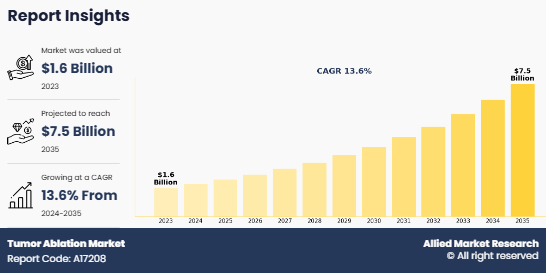
Tumor ablation is a minimally invasive therapeutic procedure used to destroy cancerous or abnormal tissue within the body. This technique uses various energy modalities, such as radiofrequency, microwave, cryotherapy, or laser, to target and eliminate tumors without the need for extensive surgery. Guided by imaging technologies such as ultrasound, CT, or MRI, tumor ablation ensures precision and minimizes damage to surrounding healthy tissues. It is commonly used for treating localized tumors in organs such as the liver, lungs, kidneys, and bones. Tumor ablation offers benefits such as reduced recovery time, lower complication rates, and suitability for patients who are not candidates for traditional surgery or chemotherapy.
Key Takeaways
- By technology, the radiofrequency ablation segment dominated the global market in terms of revenue in 2023. However, the microwave ablation segment is expected to register the highest CAGR during the forecast period.
- By treatment, the percutaneous ablation segment dominated the global market in terms of revenue in 2023. However, the laparoscopic ablation segment is expected to register the highest CAGR during the forecast period.
- By application, the liver cancer segment dominated the market in terms of revenue in 2023. However, the kidney cancer segment is expected to register the highest CAGR during the forecast period.
- By region, North America dominated the tumor ablation market share in terms of revenue in 2023. However, Asia-Pacific is expected to register the highest CAGR during the forecast period.
Market Dynamics
According to tumor ablation market forecast analysis the market growth is driven by advancements in minimally invasive treatment technologies and rise in prevalence of cancer worldwide. Increase in preference for less invasive procedures spurs the adoption of ablation techniques, which offer reduced recovery times and lower risks of complications compared to traditional surgical interventions. In addition, technological innovations, such as the development of high-precision imaging modalities and enhanced ablation devices, further improve treatment outcomes, fueling demand for tumor ablation devices in the market.
A key growth driver is the growing geriatric population, which is more susceptible to chronic diseases such as cancer, creating a higher demand for effective and minimally invasive treatment options. Increase in awareness about the benefits of tumor ablation, coupled with a rise in healthcare expenditures contributes to tumor ablation market growth.
Furthermore, according to tumor ablation market opportunity, supportive government initiatives and investments in healthcare infrastructure play a crucial role in fostering the adoption of advanced tumor ablation technologies, particularly in emerging economies.However, the high cost of equipment & procedures and the need for skilled professionals to operate advanced systems restrict growth of tumor ablation market size. On the other hand, continuous R&D, along with an increase in focus on expanding access to healthcare, are expected to provide an opportunity for market growth. Thus, the tumor ablation market is poised for robust growth, driven by technological advancements, a growing patient base, and rise in investments in innovative medical solutions.
Segments Overview
The tumor ablation market is segmented into technology, treatment, application, and region. By technology, the market is classified into radiofrequency ablation, microwave ablation, cryoablation, irreversible electroporation ablation, and other ablation technologies. By treatment, the market is segregated into surgical ablation, laparoscopic ablation, and percutaneous ablation. By application, the market is classified into kidney cancer, liver cancer, breast cancer, lung cancer, prostate cancer, bone cancer, and others. Region wise, the market is analyzed across North America, Europe, Asia-Pacific, LAMEA.
By Technology
The radiofrequency ablation segment dominated the market share in 2023. This was attributed to its widespread adoption as a minimally invasive and cost-effective treatment for various cancers. Its precision in targeting tumor tissues while sparing healthy cells, along with shorter recovery times and fewer complications, contributed to its popularity. In addition, advancements in imaging technologies enhanced procedural accuracy, further boosting demand for radiofrequency ablation. Furthermore, rise in prevalence of liver, lung, and kidney cancers, where radiofrequency ablation is commonly used, supported segment dominance.
However, the microwave ablation segment is expected to register the highest CAGR during the forecast period. This is attributed to its ability to generate higher temperatures, allowing for larger and faster tumor ablation with minimal heat dissipation to surrounding tissues. The technique's effectiveness in treating larger and more complex tumors, along with its suitability for patients with limited treatment options, has driven its adoption. Advancements in microwave ablation technology and increasing application of microwave ablation technology in the treatment of cancers, specifically in liver, lung, and bone cancers, which further support its rapid growth.
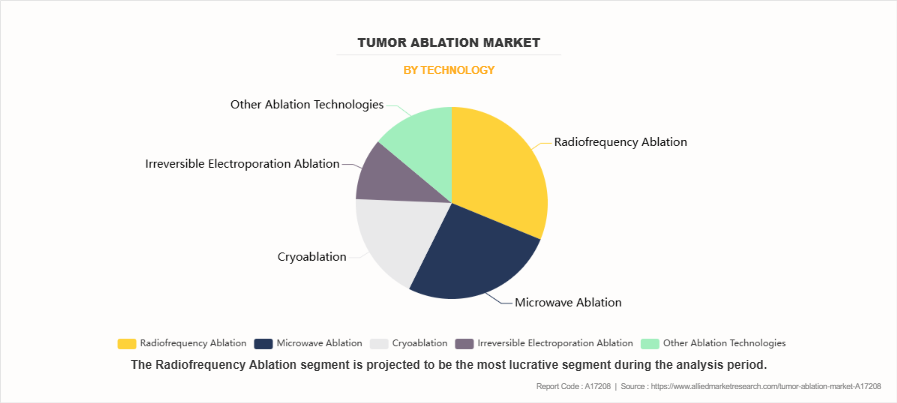
By Treatment
The percutaneous ablation segment dominated the global tumor ablation market share in 2023, owing to its minimally invasive nature and ability to deliver targeted treatment with reduced risk of complications. Its widespread use in outpatient settings, coupled with shorter recovery times and cost-effectiveness, made it a preferred choice among healthcare providers and patients. Advancements in imaging technologies, such as CT and ultrasound, enhanced the precision of percutaneous procedures, further driving their adoption. In addition, the increasing prevalence of cancers suitable for percutaneous ablation, such as liver and lung tumors, contributed to its market leadership.
However, the laparoscopic ablation segment is expected to register the highest CAGR during the forecast period. This is attributed to its ability to provide direct visualization of tumors, enabling precise treatment in complex cases. The technique offers a minimally invasive alternative to open surgery, reducing recovery time and postoperative complications. Its growing adoption for treating tumors located in hard-to-reach areas, coupled with advancements in laparoscopic tools and imaging technologies further propelled the demand for laparoscopic.
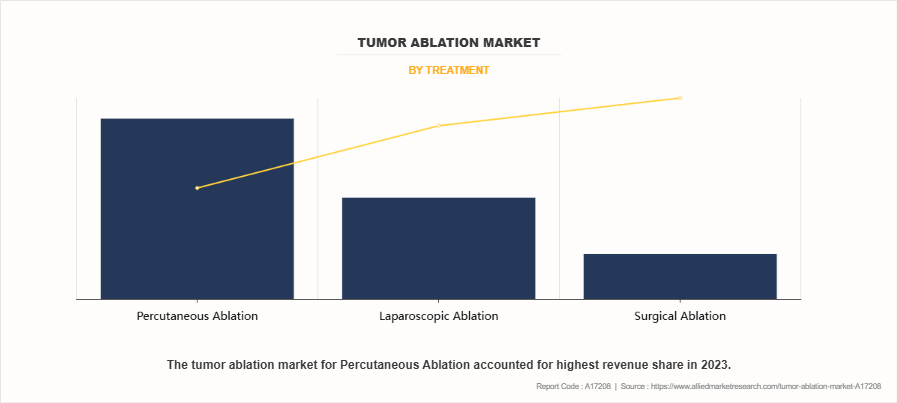
By Application
The liver cancer segment dominated the global tumor ablation market share in 2023, owing to the high prevalence of liver cancer cases worldwide and the surge in preference for minimally invasive treatment options. Tumor ablation techniques, such as radiofrequency and microwave ablation, are widely used for liver cancer due to their effectiveness in treating localized tumors while preserving healthy liver tissue. Rise in incidence of liver cancer, often linked to factors such as hepatitis infections and alcohol consumption, further fueled demand for liver cancer treatment options such as tumor ablation.
However, the kidney cancer segment is expected to register the highest CAGR during the forecast period. This is attributed to the increase in prevalence of kidney cancer globally and the growing adoption of minimally invasive treatments for renal tumors. Tumor ablation techniques, such as radiofrequency and microwave ablation, offer effective alternatives to surgical interventions, especially for patients unfit for surgery. Advancements in ablation technologies and imaging guidance have improved the precision and outcomes of kidney cancer treatments.
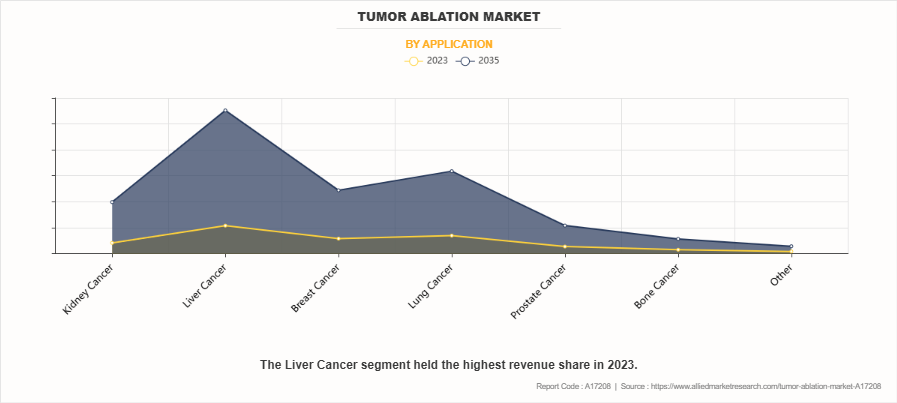
By Region
The tumor ablation industry is analyzed across North America, Europe, Asia-Pacific, LAMEA. North America accounted for the largest share in the tumor ablation market in 2023. This dominance is attributed to the rise in prevalence of cancer, well-established healthcare infrastructure, and early adoption of advanced medical technologies in the region. Increased government funding for cancer research and a strong presence of key market players have further boosted the availability and accessibility of innovative tumor ablation solutions. In addition, growing awareness among patients and healthcare providers about minimally invasive treatment options, along with favorable reimbursement policies, has significantly contributed to the market's leadership in North America.
However, the Asia-Pacific region is anticipated to register the highest CAGR during the forecast period. This is attributed to increasing incidence of cancer, particularly liver and lung cancers, in rapidly growing populations across countries such as China, India, and Japan. The region has witnessed improvements in healthcare infrastructure, along with greater access to advanced medical technologies and treatment options.
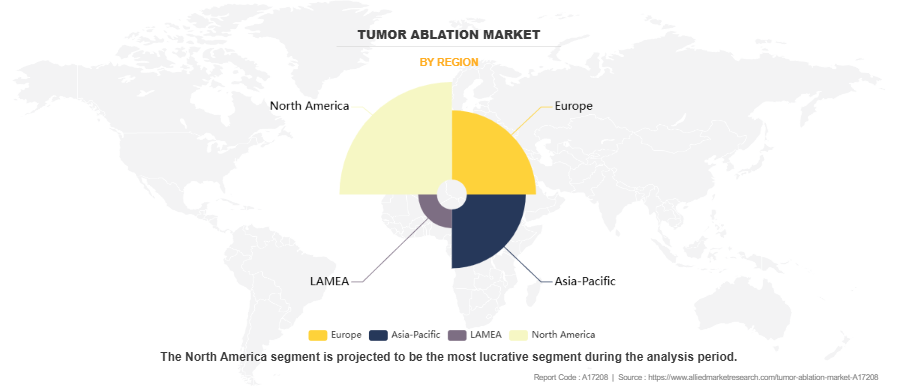
Competitive Analysis
Key players such as Siemens and IceCure Medical Ltd. adopted product approval, acquisition, clinical trial expansion, and agreement as key developmental strategies to improve the product portfolio of the tumor ablation market. For instance, in January 2021, IceCure Medical Ltd. announced that an expanded distribution agreement in Thailand with its strategic partner, Terumo Corporation, a leading Japanese medical devices company with a global footprint, was signed on December 28, 2020.
Recent Developments in the Tumor Ablation Industry
- In December 2024, AngioDynamics, Inc. announced that it received U.S. Food and Drug Administration (FDA) 510(k) clearance for the NanoKnife System for prostate tissue ablation.
- In March 2024, Medtronic plc, a global leader in healthcare technology announced that it received U.S. Food and Drug Administration (FDA) 510(k) clearance for its OsteoCool 2.0 bone tumor ablation system for the treatment of painful bone metastases and benign bone tumors such as osteoid osteoma.
- In May 2023, Integra LifeSciences Holdings Corporation held a ribbon-cutting ceremony on May 11, 2023, to mark the grand opening and dedication of its new Center of Innovation and Learning in Plainsboro, New Jersey. The facility was named in honor of Dr. Richard E. Caruso, the late founder of the company.
- In June 2022, IceCure Medical Ltd. announced that its wholly owned subsidiary, IceCure (Shanghai) MedTech Co., Ltd. signed an exclusive distribution agreement for ProSense System (marketed under the brand name IceSense3 in China) with Shanghai Medtronic Zhikang Medical Devices Co. Ltd., an affiliate of Medtronic plc Beijing Turing Medical Technology Co. Ltd. ("Turing"). The first IceSense3 systems are expected to be delivered in 2022.
- In September 2022, Stryker announced that its OptaBlate bone tumor ablation system (OptaBlate) received 510(k) clearance from the U.S. Food and Drug Administration.
- In October 2021, Bioventus Inc. completed the acquisition of Misonix, Inc., a provider of minimally invasive therapeutic ultrasonic technologies and regenerative medicine that are designed to enhance clinical outcomes, for cash and common stock. Pursuant to the terms of the merger agreement, Misonix has become a wholly owned subsidiary of Bioventus
Key Benefits for Stakeholders
- This report provides a quantitative analysis of the market segments, current trends, estimations, and dynamics of the tumor ablation market analysis from 2023 to 2035 to identify the prevailing tumor ablation market opportunities.
- The market research is offered along with information related to key drivers, restraints, and opportunities.
- Porter's five forces analysis highlights the potency of buyers and suppliers to enable stakeholders make profit-oriented business decisions and strengthen their supplier-buyer network.
- In-depth analysis of the tumor ablation market segmentation assists to determine the prevailing market opportunities.
- Major countries in each region are mapped according to their revenue contribution to the global market.
- Market player positioning facilitates benchmarking and provides a clear understanding of the present position of the market players.
- The report includes the analysis of the regional as well as global tumor ablation market trends, key players, market segments, application areas, and market growth strategies.
Tumor Ablation Market Report Highlights
| Aspects | Details |
| Market Size By 2035 | USD 7.5 billion |
| Growth Rate | CAGR of 13.6% |
| Forecast period | 2023 - 2035 |
| Report Pages | 372 |
| By Technology |
|
| By Treatment |
|
| By Application |
|
| By Region |
|
| Key Market Players | AngioDynamics, Inc., Medtronic Plc, Integra LifeSciences Holdings Corporation, IceCure Medical Ltd., Siemens, Boston Scientific Corporation, Stryker Corporation, Johnson & Johnson, Olympus Corporation, Bioventus Inc. |
Analyst Review
This section provides various opinions of top-level CXOs in the global tumor ablation market. According to the insights of CXOs, the global tumor ablation market is expected to exhibit high growth potential attributable to rising prevalence of cancer worldwide and the increasing demand for minimally invasive treatment options. Advancements in ablation technologies, such as microwave and radiofrequency ablation, along with improved imaging techniques, are driving innovation in the market. However, high treatment costs, the risk of complications, and the limited reimbursement in certain regions, which restrict patient access. further hinders market growth. CXOs further added that the expanding healthcare infrastructure in emerging economies, growing awareness about early cancer diagnosis, and supportive government initiatives further contribute to the strong growth prospects for the tumor ablation market.
Furthermore, North America dominated the market share, in terms of revenue in 2023, owing to advanced healthcare infrastructure, early adoption of cutting-edge tumor ablation technologies, and strong presence of key market players. The growing demand for minimally invasive procedures and technological advancements in ablation therapies also contributed to North America's market dominance. However, Asia-Pacific is anticipated to witness notable growth owing to an increasing healthcare investment, rising cancer incidence, and growing awareness about advanced treatment options. In addition, the region’s expanding healthcare infrastructure, along with the adoption of minimally invasive procedures and technological advancements in tumor ablation, further supports its rapid growth.
The total market value of Tumor Ablation market is $1.6 billion in 2023.
The market value of Tumor Ablation market in 2035 is $7.5 billion.
The forecast period for Tumor Ablation market is 2024-2033.
The base year is 2023 in Tumor Ablation market
Major key players that operate in the Tumor Ablation market are AngioDynamics, Inc., Olympus Corporation, Medtronic Plc, Bioventus Inc.Integra LifeSciences Holdings Corporation, Johnson & Johnson.
Loading Table Of Content...
Loading Research Methodology...



